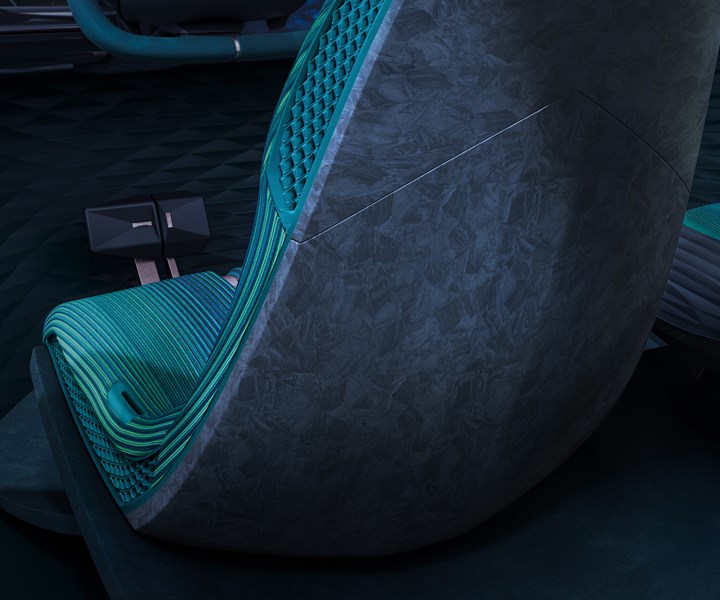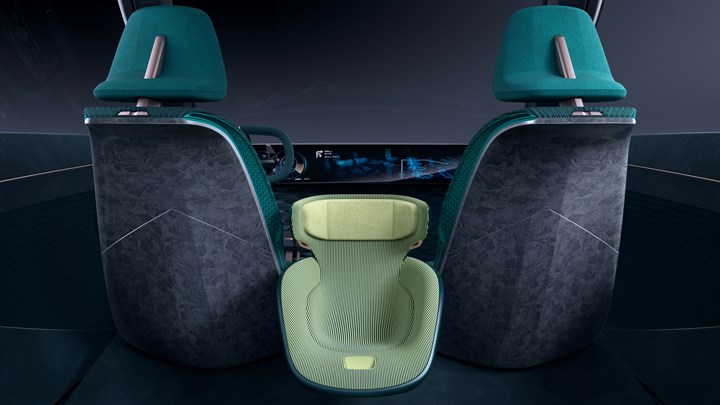Thermoplastic composites incorporated into vehicle seatback concept
Covestro’s Maezio carbon fiber-reinforced thermoplastic composites were used to develop a lightweight, sustainable seatback concept for a Chinese car manufacturer.

Source | Covestro
Covestro (Leverkusen, Germany) announced on Jan. 14 that it has partnered with the Research and Development Center of Guangzhou Automobile Group Co. Ltd. (GAC R&D Center; Guangzhou, China) to develop a lightweight composite seat back for the car manufacturer’s latest electric concept car, the ENO.146.
The ENO.146 is designed to be a highly aerodynamically efficient vehicle, with a drag coefficient of only 0.146 and a New European Driving Cycle (NEDC) range of 1,000 kilometers. Efforts to reduce vehicle weight and increase sustainability have resulted in the selection of Covestro’s Maezio carbon fiber-reinforced thermoplastic composite (CFRTP) material for the backrests of the concept car’s front seats. Compared to typical metal constructions, the CFRTP seat backrest results in estimated weight savings of up to 50%.
“Seats in the passenger compartment are an ideal target for weight savings, as they are among the heaviest parts there,” says Lisa Ketelsen, head of Covestro’s thermoplastic composites business. “Fiber-reinforced composites are the ideal material for lightweight automotive construction, but Maezio can further simplify molding and streamline the manufacturing process.”
According to Covestro, fittings and other attachments add to the complexity of production and assembly for seats with metal backrests. Because Maezio is a thermoplastic material, parts and functions can be consolidated by injection molding processing. Functional structures are incorporated into the mold for shaping the backrest, reducing the number of parts and materials.

Source | Covestro
The backrest also needed to meet the aesthetic and sustainability goals of the vehicle interior, which was designed with green colors and patterns reminiscent of nature and to incorporate sustainable or recyclable materials. The Maezio material is able to be cut and shaped into the desired marble-like pattern, fitting aesthetic requirements, and can be reused at the end of its service life, which suited the team’s sustainability needs.
“Mobility trends such as electrification and autonomous driving are redefining the role and function of car interiors,” says Zhang Fan, vice president of the GAC R&D Center. “There is a growing need for material solutions that are lightweight and sustainable while opening up ways to create new user experiences ranging from visual to tactile feedback.”
The vehicle recently made its debut at the Guangzhou International Automobile Exhibition.
Related Content
-
Plant tour: Collins Aerospace, Riverside, Calif., U.S. and Almere, Netherlands
Composite Tier 1’s long history, acquisition of stamped parts pioneer Dutch Thermoplastic Components, advances roadmap for growth in thermoplastic composite parts.
-
JEC World 2024 highlights: Thermoplastic composites, CMC and novel processes
CW senior technical editor Ginger Gardiner discusses some of the developments and demonstrators shown at the industry’s largest composites exhibition and conference.
-
Co-molding SMC with braided glass fiber demonstrates truck bed potential
Prepreg co-molding compound by IDI Composites International and A&P Technology enables new geometries and levels of strength and resiliency for automotive, mobility.

.jpg;width=70;height=70;mode=crop)














